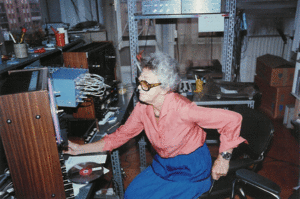Teresa Rampazzi facts for kids
Teresa Rampazzi (born Teresa Rossi) was an Italian musician. She was born on October 31, 1914, and passed away on December 16, 2001. Teresa was a talented pianist and a composer. She was also a very important pioneer in creating music using electronic devices and computers.
Biography
Teresa Rampazzi was born in Vicenza, Italy. She started playing the piano when she was a child. Later, she studied at the Milan Conservatory and earned her piano diploma in 1933. During her time at the conservatory, she met other musicians like Severino Gazzelloni and Franco Donatoni, who became her good friends.
After getting married, Teresa lived in different Italian cities, including Vicenza, Venice, and Verona. In 1955, she moved to Padua with her husband. There, she joined music groups like the Trio Bartók and the Circolo Pozzetto.
Teresa became very interested in new and experimental music, often called "avant-garde." In the 1950s, she went to the Ferienkurse Darmstadt in Germany. This is where she first heard a special machine called a frequency generator, which makes different sounds.
In February 1959, a famous American composer named John Cage visited Padua. Teresa Rampazzi performed a concert with him and other musicians. They played some of John Cage's unique pieces, like "Music for Piano" and "Variations I & II."
Later, Teresa sold her piano to buy equipment for making electronic music. She teamed up with Ennio Chiggio to create the NPS Group (Nuove Proposte Sonore). This group was an experimental team that explored how to make sounds using electronic machines. (Her husband actually bought her piano back later!)
Teresa worked with Ennio Chiggio until 1968. She continued her work with the NPS group until 1972. That year, she started teaching electronic music at the Padova Conservatory. This was one of the first courses of its kind in Italy. She kept researching sounds and wrote articles about electronic music.
She also worked with music studios around the world. These included the Institute of Sonology in Utrecht, the Catholic University in Washington, and the electromusic studio in Stockholm. She also worked with computer music departments at the University of Pisa and in Padua.
After her husband passed away in 1983, Teresa Rampazzi moved to Assisi and then to Bassano. She continued to compose music there. Teresa Rampazzi died in Bassano del Grappa in 2001.
Works
Teresa Rampazzi created her music using electronic sound generation. This means she used machines to make sounds, which she then recorded on tape. Her electronic compositions were sometimes used in documentary films and for ballets. Here are some of her selected works:
- ipotesi1 (1965)
- ipotesi2 (1965)
- Research1 (1965)
- Ricerca2 (1965)
- Ricerca3 (1965)
- Ricerca4 (1965)
- Operation 1 (1966)
- Operation 2 (1966)
- Operation 3 (1966)
- Function 1 (1966)
- Function 3 (1966)
- Function 4 (2 tracks)(1966)
- Function 3 (1966)
- Function 5 (1966)
- 5th Function (1966)
- Rhythm 1 (1967)
- Rhythm 2 (1967)
- Rhythm 3 (1967)
- Module 1 (1967)
- Module 2 (1967)
- Module 3 (1967)
- Module 4 (1967)
- Module 5 (1967)
- Interference 1 (1968)
- Interference 2 (1968)
- Dynamics 1 (1968)
- Masse 1 (1968)
- Masse 2 (1968)
- Freq Mod 1 (1969)
- Freq Mod 2 (1969)
- Imp & Ritha (1970)
- Environ (1970)
- Collections (1970)
- Eco 1 (1971)
- Filter 1 (1971)
- Taras on 3 (1971)
- Immagini per Diana Baylon (1972)
- Computer 1800 (1972)
- Hardlag (1972)
- With the light pen (1976)
- noch atmen (1980) (won second prize in Bourges)
- Geometry in motion (1982)
- Almost a Haiku (1987)
- Polifonie di Novembre (1988)
See also
 In Spanish: Teresa Rampazzi para niños
In Spanish: Teresa Rampazzi para niños


